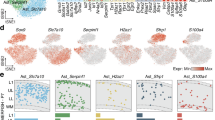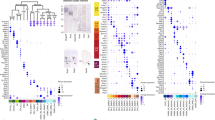Abstract
In the developing vertebrate nervous system, multipotent neural stem cells produce both neurons and glia. OLIG2 is a basic helix–loop–helix transcription factor that plays critical roles in oligodendrocyte and motor neuron development; however, its role in astrocytic development remains elusive. In this study, we analyzed an effect of OLIG2 on cytokine-induced astrocytic differentiation from mouse telencephalic neuroepithelial cells. We show that the presence of OLIG2 protein leads to inhibition of the promoter activation of astrocyte-specific glial fibrillary acidic protein gene. We found that OLIG2 abolishes complex formation between a transcriptional coactivator p300 and a transcription factor, signal transducer and activator of transcription 3 (STAT3), which is activated by astrocytic differentiation-inducing cytokines, such as leukemia inhibitory factor (LIF). The enforced expression of OLIG2 in neuroepithelial cells inhibits the LIF-induced astrocytic differentiation. We also show that the OLIG2 protein in the nuclei of neural precursor cells disappears in accordance with astrocytic differentiation during culture with LIF. Together, these results reveal a novel molecular function of OLIG2 on the astrocyte development.
Similar content being viewed by others
Log in or create a free account to read this content
Gain free access to this article, as well as selected content from this journal and more on nature.com
or
Abbreviations
- STAT3:
-
signal transducer and activator of transcription 3
- LIF:
-
leukemia inhibitory factor
- GFAP:
-
glial fibrillary acidic protein
- bHLH:
-
basic helix–loop–helix
- GFP:
-
green fluorescent protein
- bFGF:
-
basic fibroblast growth factor
References
Anderson DJ (2001) Stem cells and pattern formation in the nervous system: the possible versus the actual. Neuron 30: 19–35
Gage FH (2000) Mammalian neural stem cells. Science 287: 1433–1438
McKay R (1997) Stem cells in the central nervous system. Science 276: 66–71
Edlund T and Jessell TM (1999) Progression from extrinsic to intrinsic signaling in cell fate specification: a view from the nervous system. Cell 96: 211–224
Nakashima K and Taga T (2002) Mechanisms underlying cytokine-mediated cell-fate regulation in the nervous system. Mol. Neurobiol. 25: 233–244
Taga T and Kishimoto T (1997) Gp130 and the interleukin-6 family of cytokines. Annu. Rev. Immunol. 15: 797–819
Bonni A, Sun Y, Nadal-Vicens M, Bhatt A, Frank DA, Rozovsky I, Stahl N, Yancopoulos GD and Greenberg ME (1997) Regulation of gliogenesis in the central nervous system by the JAK-STAT signaling pathway. Science 278: 477–483
Nakashima K, Yanagisawa M, Arakawa H, Kimura N, Hisatsune T, Kawabata M, Miyazono K and Taga T (1999) Synergistic signaling in fetal brain by STAT3-Smad1 complex bridged by p300. Science 284: 479–482
Yanagisawa M, Nakashima K and Taga T (1999) STAT3-mediated astrocyte differentiation from mouse fetal neuroepithelial cells by mouse oncostatin M. Neurosci. Lett. 269: 169–172
Yanagisawa M, Nakashima K, Arakawa H, Ikenaka K, Yoshida K, Kishimoto T, Hisatsune T and Taga T (2000) Astrocyte differentiation of fetal neuroepithelial cells by interleukin-11 via activation of a common cytokine signal transducer, gp130, and a transcription factor, STAT3. J. Neurochem. 74: 1498–1504
Ochiai W, Yanagisawa M, Takizawa T, Nakashima K and Taga T (2001) Astrocyte differentiation of fetal neuroepithelial cells involving cardiotrophin-1-induced activation of STAT3. Cytokine 14: 264–271
Uemura A, Takizawa T, Ochiai W, Yanagisawa M, Nakashima K and Taga T (2002) Cardiotrophin-like cytokine induces astrocyte differentiation of fetal neuroepithelial cells via activation of STAT3. Cytokine 18: 1–7
Gross RE, Mehler MF, Mabie PC, Zang Z, Santschi L and Kessler JA (1996) Bone morphogenetic proteins promote astroglial lineage commitment by mammalian subventricular zone progenitor cells. Neuron 17: 595–606
Massague J and Chen YG (2000) Controlling TGF-beta signaling. Genes Dev. 14: 627–644
Guillemot F, Lo LC, Johnson JE, Auerbach A, Anderson DJ and Joyner AL (1993) Mammalian achaete-scute homolog 1 is required for the early development of olfactory and autonomic neurons. Cell 75: 463–476
Ben-Arie N, Bellen HJ, Armstrong DL, McCall AE, Gordadze PR, Guo Q, Matzuk MM and Zoghbi HY (1997) Math1 is essential for genesis of cerebellar granule neurons. Nature 390: 169–172
Ma Q, Chen Z, del Barco Barrantes I, de la Pompa JL and Anderson DJ (1998) Neurogenin1 is essential for the determination of neuronal precursors for proximal cranial sensory ganglia. Neuron 20: 469–482
Fode C, Gradwohl G, Morin X, Dierich A, LeMeur M, Goridis C and Guillemot F (1998) The bHLH protein NEUROGENIN 2 is a determination factor for epibranchial placode-derived sensory neurons. Neuron 20: 483–494
Lu QR, Yuk D, Alberta JA, Zhu Z, Pawlitzky I, Chan J, McMahon AP, Stiles CD and Rowitch DH (2000) Sonic hedgehog-regulated oligodendrocyte lineage genes encoding bHLH proteins in the mammalian central nervous system. Neuron 25: 317–329
Zhou Q, Wang S and Anderson DJ (2000) Identification of a novel family of oligodendrocyte lineage-specific basic helix–loop–helix transcription factors. Neuron 25: 331–343
Takebayashi H, Yoshida S, Sugimori M, Kosako H, Kominami R, Nakafuku M and Nabeshima Y (2000) Dynamic expression of basic helix–loop–helix Olig family members: implication of Olig2 in neuron and oligodendrocyte differentiation and identification of a new member, Olig3. Mech. Dev. 99: 143–148
Mizuguchi R, Sugimori M, Takebayashi H, Kosako H, Nagao M, Yoshida S, Nabeshima Y, Shimamura K and Nakafuku M (2001) Combinatorial roles of Olig2 and Neurogenin2 in the coordinated induction of pan-neuronal and subtype-specific properties of motoneurons. Neuron 31: 757–771
Novitch BG, Chen AI and Jessell TM (2001) Coordinate regulation of motor neuron subtype identity and pan-neuronal properties by the bHLH repressor Olig2. Neuron 31: 773–789
Zhou Q and Anderson DJ (2002) The bHLH transcription factors OLIG2 and OLIG1 couple neuronal and glial subtype specification. Cell 109: 61–73
Eckner R, Yao TP, Oldread E and Livingston DM (1996) Interaction and functional collaboration of p300/CBP and bHLH proteins in muscle and B-cell differentiation. Genes Dev. 10: 2478–2490
Mutoh H, Naya FJ, Tsai MJ and Leiter AB (1998) The basic helix–loop–helix protein BETA2 interacts with p300 to coordinate differentiation of secretin-expressing enteroendocrine cells. Genes Dev. 12: 820–830
Monte D, DeWitte F and Hum DW (1998) Regulation of the human P450scc gene by steroidogenic factor 1 is mediated by CBP/p300. J. Biol. Chem. 273: 4585–4591
Yang C, Shapiro LH, Rivera M, Kumar A and Brindle PK (1998) A role for CREB binding protein and p300 transcriptional coactivators in Ets-1 transactivation functions. Mol. Cell. Biol. 18: 2218–2229
Temple S (2001) The development of neural stem cells. Nature 414: 112–117
Nakashima K, Takizawa T, Ochiai W, Yanagisawa M, Hisatsune T, Nakafuku M, Miyazono K, Kishimoto T, Kageyama R and Taga T (2001) BMP2-mediated alteration in the developmental pathway of fetal mouse brain cells from neurogenesis to astrocytogenesis. Proc. Natl. Acad. Sci. USA 98: 5868–5873
Sun Y, Nadal-Vicens M, Misono S, Lin MZ, Zubiaga A, Hua X, Fan G and Greenberg ME (2001) Neurogenin promotes neurogenesis and inhibits glial differentiation by independent mechanisms. Cell 104: 365–376
Mekki-Dauriac S, Agius E, Kan P and Cochard P (2002) Bone morphogenetic proteins negatively control oligodendrocyte precursor specification in the chick spinal cord. Development 129: 5117–5130
Zhou Q, Choi G and Anderson DJ (2001) The bHLH transcription factor Olig2 promotes oligodendrocyte differentiation in collaboration with Nkx2.2. Neuron 31: 791–807
Morita S, Kojima T and Kitamura T (2000) Plat-E: an efficient and stable system for transient packaging of retroviruses. Gene Therapy 7: 1063–1066
Acknowledgements
We thank Dr. K Ikenaka for helpful discussion and Dr. M Raff for critical reading of the manuscript. We also thank Dr. T Kitamura for Plat-E cells, and members of our laboratory for valuable discussions and technical advice. We are very grateful to Ms. Y Noguchi for her secretarial assistance, and also thank Ms. K Kaneko and Ms. Y Saiki for technical help. This work was supported in part by grant-in-aid for 21st Century COE Research from Ministry of Education, Science and Culture ‘Cell Fate Regulation Research and Education Unit’; Scientific Research (B); Specially Promoted Research from the Ministry of Education, Culture, Science, Sports and Technology; Nakajima Foundation; Uehara Memorial Foundation; Japan Brain Foundation; Higo Foundation; Human Frontier Science Program; and the Virtual Research Institute of Aging of Nippon Boehringer Ingelheim.
Author information
Authors and Affiliations
Corresponding authors
Additional information
Edited by H Ichijo
Rights and permissions
About this article
Cite this article
Fukuda, S., Kondo, T., Takebayashi, H. et al. Negative regulatory effect of an oligodendrocytic bHLH factor OLIG2 on the astrocytic differentiation pathway. Cell Death Differ 11, 196–202 (2004). https://doi.org/10.1038/sj.cdd.4401332
Received:
Revised:
Accepted:
Published:
Issue date:
DOI: https://doi.org/10.1038/sj.cdd.4401332
Keywords
This article is cited by
-
Region-specific distribution of Olig2-expressing astrocytes in adult mouse brain and spinal cord
Molecular Brain (2021)
-
Cell signaling pathways in autosomal-dominant leukodystrophy (ADLD): the intriguing role of the astrocytes
Cellular and Molecular Life Sciences (2021)
-
Immunoprecipitation and mass spectrometry define TET1 interactome during oligodendrocyte differentiation
Cell & Bioscience (2020)
-
Separated at birth? The functional and molecular divergence of OLIG1 and OLIG2
Nature Reviews Neuroscience (2012)
-
Neuroprotection by leptin in a rat model of permanent cerebral ischemia: effects on STAT3 phosphorylation in discrete cells of the brain
Cell Death & Disease (2011)



